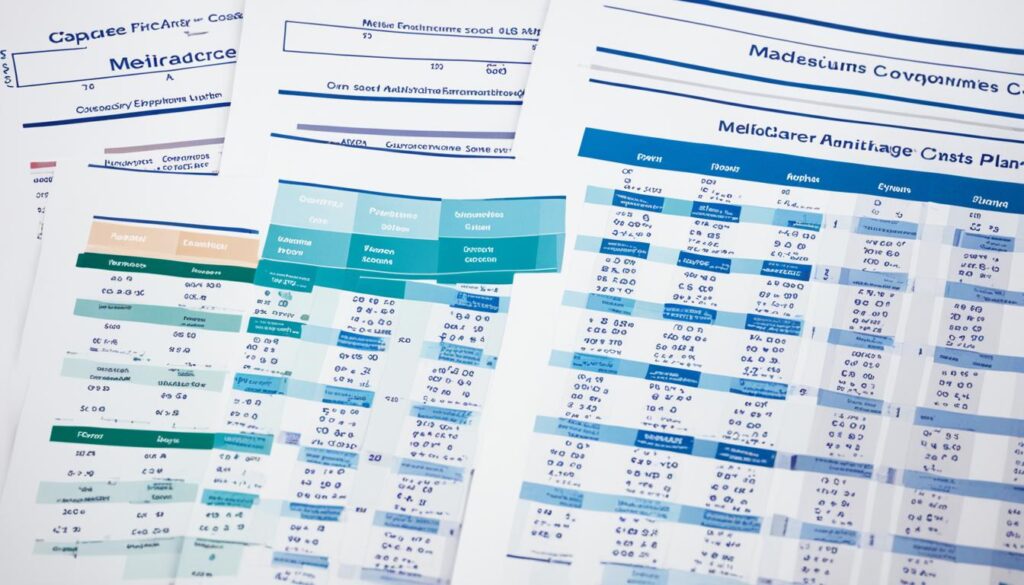Let’s discuss a topic that is significant to us: our health. We value the moments we share with family and friends, the experiences we create, and the small pleasures that bring value to our lives. But what happens when our health requires assistance?
My name is Sarah, and like many of you, I’ve faced the challenge of navigating the complex world of healthcare. It can be overwhelming, confusing, and even scary at times. That’s why I want to share some important information with you today about Medicare Advantage, a healthcare option that could make a big difference in your life.
Medicare Advantage plans offer a variety of benefits, coverage options, and provider networks that can help you take control of your health and well-being. Whether you’re looking for comprehensive coverage, enhanced benefits, or cost-saving opportunities, Medicare Advantage has something for everyone.
Join me as we explore the basics of Medicare Advantage, understanding how it works, the different plan options available, the costs involved, and the eligibility requirements. By the end, you’ll have a clearer picture of how Medicare Advantage can fit into your healthcare journey.
Remember, our health matters, and having the right information can empower us to make informed decisions that positively impact our lives and the lives of our loved ones.
Key Takeaways:
- Medicare Advantage is a healthcare option that offers a variety of benefits, coverage options, and provider networks.
- Understanding the basics of Medicare Advantage can help you make an informed decision about your healthcare.
- There are different types of Medicare Advantage plans, each with its own rules, provider networks, and coverage options.
- Medicare Advantage may have different cost structures compared to Original Medicare, including premiums, copayments, and out-of-pocket limits.
- Enrollment in Medicare Advantage typically occurs during specific enrollment periods, and eligibility requirements must be met.
What is Medicare Advantage?
Medicare Advantage is a type of Medicare health plan offered by private companies that contract with Medicare. These plans provide Part A and Part B coverage, and many also offer Part D prescription drug coverage. Medicare Advantage plans may have different rules and cost-sharing structures compared to Original Medicare, and they may offer additional benefits that Original Medicare does not cover.
Medicare Advantage plans have gained popularity due to the added benefits and flexibility they offer. By enrolling in a Medicare Advantage plan, you can receive your Medicare coverage through a private insurance company of your choice. These plans are required to offer at least the same level of coverage as Original Medicare, but they often include additional benefits like dental, vision, and hearing services.
| Medicare Advantage | Original Medicare |
|---|---|
| Part A (Hospital Insurance) | Part A (Hospital Insurance) |
| Part B (Medical Insurance) | Part B (Medical Insurance) |
| Additional benefits (e.g., dental, vision, hearing) | Limited additional benefits |
| Prescription drug coverage (in most plans) | May require separate Part D plan |
| Out-of-pocket maximums and cost-sharing | Original Medicare does not have an out-of-pocket maximum |
Medicare Advantage plans offer individuals the convenience of having all their healthcare needs managed by a single insurance company. These plans often have networks of doctors, hospitals, and specialists that members must use to receive full benefits.
Medicare Advantage plans provide a comprehensive alternative to Original Medicare. They offer additional benefits and coordinated care through private insurance companies, giving you greater choice and flexibility in managing your healthcare.
It’s important to note that every Medicare Advantage plan is unique, so it’s essential to review and compare different plans to find the one that best suits your specific needs and budget. Keep in mind that you must continue paying your Part B premium, even if you’re enrolled in a Medicare Advantage plan.
How does Medicare Advantage work?
When you join a Medicare Advantage plan, the plan receives a fixed amount from Medicare to provide your healthcare coverage. This means that the plan is responsible for coordinating and delivering your Medicare benefits. However, it’s important to note that while the plan must follow Medicare’s rules, it can charge different out-of-pocket costs and have different network restrictions.
Medicare Advantage plans cover all of your Part A and Part B benefits, which include hospital stays, doctor visits, and medical services. In addition to these basic benefits, some Medicare Advantage plans also offer extra benefits that Original Medicare does not cover. These additional benefits can include vision, hearing, and dental services, as well as wellness programs, transportation assistance, and prescription drug coverage.
One important aspect of Medicare Advantage plans is that they have an annual limit on out-of-pocket costs. This means that once you reach this limit, the plan will cover 100% of the costs for covered services for the rest of the year. This provides you with financial protection and peace of mind.
“Medicare Advantage plans offer comprehensive coverage for your Part A and Part B benefits, and may include additional benefits like vision and dental services.”
It’s worth mentioning that each Medicare Advantage plan may have its own set of rules and guidelines, so it’s essential to review the specific details of the plan you are considering. This can include restrictions on the network of healthcare providers that you can use, as well as requirements for obtaining referrals or prior authorization for certain services.
Overall, Medicare Advantage offers a comprehensive and convenient way to receive your Medicare benefits. By choosing a plan that aligns with your healthcare needs and preferences, you can take advantage of the additional benefits and potential cost savings that these plans offer.

Types of Medicare Advantage plans
When it comes to Medicare Advantage, there are several types of plans to choose from, each offering unique benefits and features. Understanding these different plan types can help you find the one that best suits your healthcare needs. Let’s explore the various options:
1. Health Maintenance Organizations (HMOs)
HMO Medicare Advantage plans typically require you to select a primary care physician (PCP) who will coordinate your healthcare services. You will generally need a referral from your PCP to see specialists or receive certain treatments. HMO plans often have a network of providers you must use to receive coverage, except in emergencies.
2. Preferred Provider Organizations (PPOs)
PPO Medicare Advantage plans offer more flexibility when it comes to choosing healthcare providers. You do not need a referral to see a specialist, giving you greater autonomy in managing your healthcare. PPO plans typically have a network of preferred providers, but you are also covered if you choose to go out-of-network, although at a higher cost.
3. Private Fee-for-Service (PFFS) plans
PFFS Medicare Advantage plans allow you to see any healthcare provider as long as they accept the plan’s payment terms and conditions. These plans determine how much they will pay for services, and providers can choose to accept or decline these terms. With PFFS plans, you may have more freedom in choosing doctors and hospitals.
4. Special Needs Plans (SNPs)
SNP Medicare Advantage plans are designed to meet the unique healthcare needs of individuals with specific conditions or characteristics. Examples of SNPs include plans for those with chronic illnesses, institutionalized individuals, or dual-eligible beneficiaries who qualify for both Medicare and Medicaid. These plans offer specialized care and tailored benefits for their target population.
5. Provider Sponsored Organizations (PSOs)
PSO Medicare Advantage plans are offered by healthcare providers such as hospitals, medical centers, or physician groups. These organizations directly sponsor the Medicare Advantage plans they offer and may have their own network of providers. PSO plans often focus on coordinating care within their provider network to improve quality and efficiency.
6. Medical Savings Accounts (MSAs)
MSA Medicare Advantage plans combine a high-deductible health plan with a medical savings account. The plan deposits money into the savings account, and you can use these funds to pay for eligible healthcare expenses until you reach the deductible. Once the deductible is met, the plan provides coverage as specified in the policy.
Now that you have a better understanding of the types of Medicare Advantage plans available, you can start exploring the specific features and benefits offered by each plan type to find the one that best fits your healthcare needs.

Understanding Medicare Advantage costs
When considering Medicare Advantage, it’s important to understand the costs associated with these plans. Medicare Advantage plans may have different cost structures compared to Original Medicare, so it’s essential to be aware of the potential expenses you may encounter.
Medicare Advantage premiums: In addition to your Part B premium, you may be responsible for paying a monthly premium for your Medicare Advantage plan. Premium amounts can vary depending on the plan and the coverage it offers. It’s important to factor in these premiums when budgeting for your healthcare expenses.
Medicare Advantage copayments and coinsurance: Copayments are fixed amounts you pay for specific healthcare services, while coinsurance is a percentage of the cost you’re responsible for. These amounts can vary depending on the services you receive and the specific plan you choose. It’s crucial to review the details of your Medicare Advantage plan to understand the copayments and coinsurance amounts associated with different services.
Medicare Advantage out-of-pocket limit: Most Medicare Advantage plans have an annual out-of-pocket limit. This limit is the maximum amount you’ll have to pay for covered services within a calendar year. Once you reach this limit, the plan will typically cover 100% of the costs for the remainder of the year. It’s important to note that this out-of-pocket limit may not include prescription drugs or out-of-network services, so be sure to review your plan’s specific details.
By understanding these Medicare Advantage costs, you can make informed decisions about your healthcare and budget effectively. Consider your expected healthcare needs, budget, and desired level of coverage when comparing Medicare Advantage plans to find the one that best suits your unique situation.

| Costs | Description |
|---|---|
| Premiums | Monthly payments in addition to your Part B premium. |
| Copayments | Fixed amounts you pay for specific services or prescriptions. |
| Coinsurance | A percentage of the cost you’re responsible for. |
| Out-of-pocket limit | The maximum amount you’ll have to pay for covered services in a calendar year. |
Eligibility for Medicare Advantage
Medicare Advantage offers a variety of healthcare options for individuals seeking comprehensive coverage. To ensure that you meet the eligibility requirements and can enroll in a Medicare Advantage plan, it is important to understand the following:
Who can join Medicare Advantage?
To be eligible for a Medicare Advantage plan, you must have both Medicare Parts A and B. This means that you must be at least 65 years old or have a qualifying disability. Additionally, you must reside in the plan’s service area, which is typically determined by your zip code.
Medicare Advantage plans are designed to provide coordinated care and additional benefits beyond what Original Medicare offers. These plans are offered by private insurance companies that contract with Medicare to provide all your Medicare Part A and Part B benefits.
Medicare Advantage enrollment
Enrollment in a Medicare Advantage plan typically occurs during specific enrollment periods:
- Initial Enrollment Period (IEP): When you first become eligible for Medicare, you have a seven-month period to enroll in a Medicare Advantage plan. This includes the three months before your 65th birthday month, your birthday month, and the three months following your birthday month.
- Annual Enrollment Period (AEP): Occurs from October 15th to December 7th each year. During this period, you can join, switch, or discontinue a Medicare Advantage plan.
- Special Enrollment Period (SEP): May be available to individuals who experience certain qualifying events, such as moving out of the plan’s service area or losing other healthcare coverage.
It is important to note that each enrollment period has specific rules and deadlines that must be followed to ensure timely enrollment in a Medicare Advantage plan.
If you have questions about your eligibility or need assistance with the enrollment process, you can contact Medicare directly or speak with a licensed insurance agent who specializes in Medicare Advantage plans.
| Enrollment Period | Timeframe |
|---|---|
| Initial Enrollment Period (IEP) | Three months before your 65th birthday month, your birthday month, and the three months following your birthday month |
| Annual Enrollment Period (AEP) | October 15th to December 7th |
| Special Enrollment Period (SEP) | Varies depending on qualifying events |

Pros and cons of Medicare Advantage
Medicare Advantage plans offer a range of advantages that can enhance your healthcare coverage. These plans often include additional benefits beyond what Original Medicare provides, such as dental, vision, and hearing services. This can be particularly beneficial for individuals who require these services on a regular basis. Moreover, Medicare Advantage plans may offer lower out-of-pocket costs compared to Original Medicare, potentially saving you money in the long run.
However, it’s important to consider the potential drawbacks of Medicare Advantage as well. Network restrictions can sometimes limit your choice of healthcare providers, and you may need to stay within the plan’s network to receive full coverage. Additionally, certain Medicare Advantage plans may require referrals from primary care physicians for specialist visits, which can add an extra layer of administration to your healthcare journey.
It’s essential to weigh the pros and cons of Medicare Advantage to determine whether it aligns with your specific healthcare needs and preferences.
Advantages of Medicare Advantage:
- Additional benefits such as dental, vision, and hearing services
- Potentially lower out-of-pocket costs
- Option to bundle Part D prescription drug coverage
- Potential for coordinated care through a single plan
- Potential for cost savings through provider networks
Disadvantages of Medicare Advantage:
- Network restrictions limiting choice of healthcare providers
- Potential for increased administrative requirements, such as referrals for specialist visits
- Varied coverage across different plans and regions
- Restrictions on coverage outside of the plan’s service area
- Potential for plan changes on an annual basis
By carefully considering these pros and cons, you can make an informed decision about whether Medicare Advantage is the right choice for your healthcare needs. Remember to evaluate your specific requirements, preferences, and budget to ensure that you select the best Medicare coverage option for you.
Comparing Medicare Advantage with Original Medicare
When it comes to choosing your Medicare coverage, it’s important to understand the differences between Medicare Advantage and Original Medicare. Each option has its own set of benefits, costs, and limitations to consider. Let’s take a closer look at how these two options compare:
Coverage Options
Original Medicare consists of Part A (hospital insurance) and Part B (medical insurance). With Original Medicare, you have the freedom to see any doctor or visit any hospital that accepts Medicare. This gives you a wide range of choices and flexibility in managing your healthcare needs.
On the other hand, Medicare Advantage plans (also known as Medicare Part C) are offered by private insurance companies approved by Medicare. These plans combine the coverage of Part A and Part B, and often include additional benefits such as prescription drug coverage, vision, hearing, and dental services. However, Medicare Advantage plans typically have a network of preferred providers that you must use for the best coverage.
Cost Structures
With Original Medicare, you’ll typically pay a monthly premium for Part B coverage. You’ll also have deductibles, copayments, and coinsurance amounts for certain services. Supplemental insurance, such as a Medicare Supplement plan, can help cover these out-of-pocket costs.
Medicare Advantage plans may have different cost structures. Some plans may have lower monthly premiums than Original Medicare, while others may have higher premiums in exchange for additional benefits. Additionally, Medicare Advantage plans often have copayments and coinsurance for services, which can vary based on the plan and the specific services you receive.
Choosing the Right Option
When deciding between Medicare Advantage and Original Medicare, it’s important to consider your specific healthcare needs and preferences. Ask yourself questions like:
- Do I prefer the freedom to choose any provider or am I comfortable with a provider network?
- Do I require additional benefits like prescription drug coverage or dental services?
- How much am I willing to pay in monthly premiums and out-of-pocket costs?
By comparing the benefits, costs, and limitations of each option, you can make an informed decision about which Medicare coverage is best for you.
Remember, if you choose Original Medicare, you may want to consider enrolling in a Medicare Supplement plan to help cover the gaps in coverage. It’s also worth noting that you have the opportunity to switch between Original Medicare and Medicare Advantage during certain enrollment periods if your needs change.
Additional considerations for Medicare Advantage
When choosing a Medicare Advantage plan, there are a few additional factors to consider beyond the basics. These considerations can help you further narrow down your options and select the right plan for your healthcare needs.
1. Medicare Advantage network of providers
One important consideration is the network of healthcare providers associated with each Medicare Advantage plan. These networks consist of doctors, specialists, hospitals, and other healthcare professionals who have agreed to provide services to plan members at negotiated rates. It’s essential to ensure that the plan you choose includes the providers you prefer or currently see.
By staying within the plan’s network, you can maximize your benefits and potentially save on out-of-pocket costs. Outside of the network, the plan may not cover services or may require higher cost-sharing.
2. Extra benefits offered by Medicare Advantage
Medicare Advantage plans often provide additional benefits beyond what is covered by Original Medicare. These extra benefits can vary depending on the plan and may include services such as vision, hearing, dental care, wellness programs, and prescription drug coverage (Part D).
Before selecting a plan, it’s essential to review the additional benefits offered and determine if they align with your healthcare needs. For example, if you wear glasses or need regular dental care, a plan that includes these services may be advantageous for you.
3. Coverage for services not covered by Original Medicare
In addition to extra benefits, some Medicare Advantage plans may offer coverage for services that Original Medicare does not cover. These services may include fitness programs, alternative therapies, transportation assistance, and more.
Reviewing the plan’s coverage details can help you identify if any specific services you require are included. It’s essential to assess your individual healthcare needs and consider if these additional services would enhance your overall coverage.

Take the time to thoroughly research and compare Medicare Advantage plans, considering factors such as network providers, extra benefits, and coverage for additional services. This will allow you to make an informed decision and choose a plan that best meets your unique healthcare requirements.
How to enroll in Medicare Advantage
Enrolling in a Medicare Advantage plan is a straightforward process that begins with ensuring you are already enrolled in Medicare Parts A and B. Once you have Medicare coverage, you can join a Medicare Advantage plan during specific enrollment periods. Let’s explore the steps to enroll and the enrollment periods available.
-
Initial Enrollment Period (IEP): This is the seven-month period that begins three months before your 65th birthday month and ends three months after. It is the best time to enroll in Medicare Advantage as you have guaranteed access to any plan available in your area without the need to undergo medical underwriting.
-
Annual Enrollment Period (AEP): Also known as the Open Enrollment Period, this period occurs from October 15th to December 7th each year. During this time, you can join, switch, or drop a Medicare Advantage plan, giving you flexibility to choose the plan that best fits your needs.
-
Special Enrollment Period (SEP): SEP provides additional opportunities to enroll in Medicare Advantage outside of the IEP and AEP. You may qualify for an SEP if certain life events occur, such as losing employer coverage, moving out of your plan’s service area, or qualifying for a Low-Income Subsidy or Extra Help program.
Once you know which enrollment period applies to you, you can begin the process of joining a Medicare Advantage plan. This typically involves researching available plans, comparing their benefits, costs, provider networks, and additional services. You can then contact the plan directly or use the Medicare website to complete your enrollment.
Remember to ensure timely coverage, it is essential to enroll during the appropriate enrollment period and understand any deadlines. Being proactive and exploring your options will help you make an informed decision and select the Medicare Advantage plan that meets your healthcare needs and preferences.
If you’d like to learn more about Medicare Advantage enrollment periods, continue reading our Frequently Asked Questions section below.
Insert the following table:
| Enrollment Period | Timeframe | Who Can Enroll |
|---|---|---|
| Initial Enrollment Period | 3 months before 65th birthday month to 3 months after | All new Medicare beneficiaries |
| Annual Enrollment Period | October 15th to December 7th | Current Medicare beneficiaries |
| Special Enrollment Period | Varies based on qualifying events | Individuals experiencing specific life events |
Frequently asked questions about Medicare Advantage
As you explore your healthcare coverage options, you may have questions about Medicare Advantage. We’ve compiled some commonly asked questions to help provide the information you need to make informed decisions about your healthcare. Read on to find answers and additional details about Medicare Advantage.
1. What is Medicare Advantage?
Medicare Advantage, also known as Medicare Part C, is a type of Medicare health plan offered by private insurance companies. These plans provide all the benefits of Original Medicare (Part A and Part B) and may include additional benefits such as prescription drug coverage, dental, vision, and hearing services.
2. How does Medicare Advantage differ from Original Medicare?
Unlike Original Medicare, Medicare Advantage plans are offered by private insurance companies. These plans often have a specific network of doctors and hospitals you must use to receive the full benefits. Additionally, Medicare Advantage plans may have different costs, rules, and extra benefits compared to Original Medicare.
3. Can I still see my preferred doctor with Medicare Advantage?
The network of doctors and hospitals in a Medicare Advantage plan may have restrictions on which providers you can see. However, many plans offer out-of-network coverage for emergencies or special circumstances. It’s important to review the plan’s provider directory to ensure your preferred doctor or hospital is included.
4. How much does Medicare Advantage cost?
The costs of Medicare Advantage plans can vary depending on factors such as the plan’s premium, deductible, copayments, and coinsurance. Some plans may have lower monthly premiums but higher out-of-pocket costs, while others may offer higher premiums but lower out-of-pocket expenses. It’s important to review each plan’s cost structure to determine which best fits your budget and healthcare needs.
5. Can I switch from Original Medicare to Medicare Advantage?
Yes, if you are enrolled in Original Medicare (Part A and Part B), you have the option to switch to a Medicare Advantage plan during certain enrollment periods. These include the Initial Enrollment Period, the Annual Enrollment Period, and Special Enrollment Periods for qualifying circumstances. It’s important to note that you cannot have both Original Medicare and a Medicare Advantage plan at the same time.
6. What additional benefits are offered by Medicare Advantage?
Medicare Advantage plans often include additional benefits beyond what Original Medicare covers. These may include prescription drug coverage, dental, vision, hearing, and wellness programs. Each plan may offer different additional benefits, so it’s important to review the specifics of each plan you are considering.
| Benefits | Original Medicare | Medicare Advantage |
|---|---|---|
| Hospital Coverage (Part A) | ✓ | ✓ |
| Medical Coverage (Part B) | ✓ | ✓ |
| Prescription Drug Coverage (Part D) | ✓ | ✓ |
| Dental, Vision, and Hearing Services | No | ✓ |
| Wellness Programs | No | ✓ |
Conclusion
After exploring the ins and outs of Medicare Advantage, we can confidently say that it offers a range of options for individuals seeking Medicare coverage. By understanding the types of plans available, the associated costs, eligibility requirements, and the benefits they provide, you can make an informed decision about your healthcare coverage.
When evaluating Medicare Advantage plans, it’s crucial to consider your specific healthcare needs and preferences. Whether you prioritize lower out-of-pocket costs, access to a wide network of providers, or additional benefits like vision or dental services, there is a Medicare Advantage plan that can meet your requirements.
In conclusion, Medicare Advantage presents a unique opportunity to enhance your Medicare coverage and tailor it to your individual needs. By evaluating the different plans available and considering your healthcare priorities, you can embark on a healthcare journey that offers comprehensive coverage and peace of mind.
FAQ
What is Medicare Advantage?
Medicare Advantage is an alternative way to receive Medicare coverage through private companies that contract with Medicare. These plans provide Part A and Part B coverage, and many also offer Part D prescription drug coverage.
How does Medicare Advantage work?
When you join a Medicare Advantage plan, the plan receives a fixed amount from Medicare to provide your healthcare coverage. The plan must follow Medicare’s rules but can charge different out-of-pocket costs and have different network restrictions. Medicare Advantage plans cover all of your Part A and Part B benefits, and some plans may offer extra benefits like vision, hearing, and dental services.
What types of Medicare Advantage plans are available?
Medicare Advantage plans come in different types, including Health Maintenance Organizations (HMOs), Preferred Provider Organizations (PPOs), Private Fee-for-Service (PFFS) plans, Special Needs Plans (SNPs), Provider Sponsored Organizations (PSOs), and Medical Savings Accounts (MSAs).
How much does Medicare Advantage cost?
Medicare Advantage plans may have different cost structures compared to Original Medicare. You may be responsible for paying monthly premiums in addition to your Part B premium. Copayments and coinsurance amounts can vary depending on the services you receive. Most Medicare Advantage plans have an annual out-of-pocket limit to protect you from excessive costs.
Who is eligible for Medicare Advantage?
To be eligible for Medicare Advantage, you must have both Medicare Parts A and B. You must also live in the plan’s service area. Enrollment in a Medicare Advantage plan typically occurs during specific enrollment periods, such as the Initial Enrollment Period, the Annual Enrollment Period, or during a Special Enrollment Period.
What are the pros and cons of Medicare Advantage?
Medicare Advantage offers advantages such as additional benefits and potentially lower out-of-pocket costs. However, there are also disadvantages, such as network restrictions and limitations on providers. It is important to carefully consider the pros and cons when deciding whether Medicare Advantage is the right choice for you.
How does Medicare Advantage compare to Original Medicare?
Original Medicare allows you to see any doctor or hospital that accepts Medicare, while Medicare Advantage often requires you to use providers within the plan’s network. It is important to compare the benefits and costs of each option to determine which best meets your healthcare needs.
What extra considerations should I keep in mind for Medicare Advantage?
When choosing a Medicare Advantage plan, it is important to consider the network of providers available, as well as any extra benefits offered, such as vision, hearing, and dental services. Some plans may also offer coverage for additional services not covered by Original Medicare.
How do I enroll in Medicare Advantage?
To enroll in a Medicare Advantage plan, you must first be enrolled in Medicare Parts A and B. You can join a plan during your Initial Enrollment Period, the Annual Enrollment Period, or during a Special Enrollment Period if you qualify. It is important to understand the enrollment process and deadlines to ensure timely coverage.
What are some frequently asked questions about Medicare Advantage?
Some common questions include: What are the benefits of Medicare Advantage? How much does Medicare Advantage cost? Can I keep my current doctors with Medicare Advantage?









